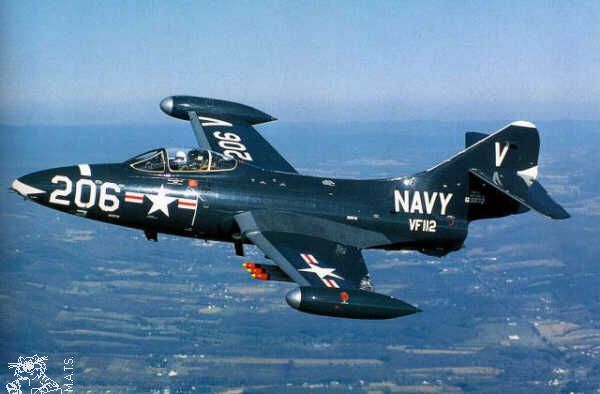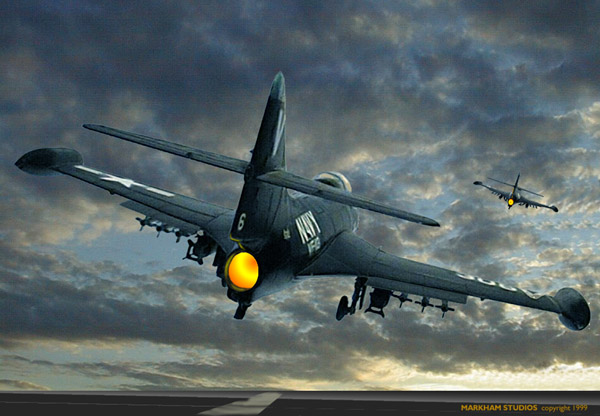Air Power
Grumman F9F Panther 
Monday morning, July 3, 1950 dawned bright and warm on the Yellow Sea, 180 miles (290 km) southwest of Inchon, South Korea. The Korean War was just 10 days old as the US Navy Carrier Valley Forge steamed north at high speed toward the 38th parallel. At 0935 hours she began launching aircraft. Jet engines began winding up from a high-pitched scream to a thunderous roar and one by one the catapult shot them forward and off the deck, clawing for altitude. The third aircraft away was flown by Lt. (jg.) Leonard Plog. The fourth was his wingman Ensign E. W. Brown. Two hours twenty minutes later the pair were over Pyongyang, North Korea in their Grumman "Panthers", riding shotgun for various Allied piston engine craft which were sent to wreak havoc on the enemy airfield located there. Spying a pair of Russian built YAK-9 piston engine craft taking off, Plog and Brown nosed over to challenge them. Plog arrived behind one YAK only to discover tracers flying past him from another enemy at "six". Pulling back hard on the stick, he was relieved to see the tracers falling away from him as Brown slid neatly astern the antagonist and put a stream of 20 mm cannon shells across the YAK from the top of the fuselage, just behind the canopy to about midway out on the left wing. There was a mighty explosion and the YAK disintegrated. It was the very first kill by a Navy jet, the Grumman Panther.
The Grumman XF9F-1 Panther began life in 1946 as design G-79, the company's first serious attempt to build a jet powered aircraft. It was a rather cluttered looking craft with 4 Westinghouse J-30 jet engines poking through the wings. Multiple engines were necessary due to the fact each engine developed only 1500 lbs. (6.67 kN) static thrust. In fact, there were so many engines there wasn’t room for fuel to run them.
As the British were a few years ahead of the US in jet engine development, the Grumman design team decided to import a single Rolls-Royce "Nene" for installation in the XF9F-2 prototype. At the same time, Pratt & Whitney was licensed by Rolls-Royce to manufacture the Nene which was a turbojet of 5,700 lbs (22.24 kN) maximum thrust. As a back-up in case the Nene project failed, Allison developed the J-33-A-8 which developed 4,600 lbs. (20.45 kN) thrust. This engine was installed in 54 F9F-3s. The Allison installation was purposely made identical to the Nene so that all Panthers could be easily switched to whichever power plant proved the most successful.
The first Nene powered XF9F-2 flew on Thanksgiving Day, 1947. It was a very sleek looking craft with elevators sitting high on a tail that jutted out past the tail pipe of the J-42 Nene. Air was scooped to the engine through triangular openings at the wing roots. It could reach 20,000 ft. (6,096 m) in just over two and a half minutes and zip along at 573 mph (922.16 kph) at that altitude. Top speed was just under 600 mph (965.61 kph) at sea level.
The Nene engine proved to be such a success, that all 54 production F9F-3s were eventually converted to dash 2s with the installation of the P&W J-42-P-6 (Nene). A total of 101 F9F-2s were thus produced. By odd coincidence, Russia was also licensed to build the same engine and they used it in their famous MIG-15 which would shortly be the Panthers adversary.
The first license built Nene powered F9F-2 Panther flew on November 24, 1948. Permanently mounted wing tip fuel tanks were added to this production model to increase the range and all production Panthers retained this feature. Four 20 mm cannons were mounted in the nose, giving the Panther awesome firepower.
It has been said the military views a new weapon as a Christmas tree. They just keep hanging things on it. They managed to hang enough ornaments on the dash 2 to increase its empty weight from 7,101 lbs. (3,221 kg) to 9,303 lbs. (4,219.84 kg) with a corresponding reduction in speed from 594 mph (955.95 kph) to 575 mph (925.37 kph) and climb rate from 7,700 ft/min (39.12 m/s) to 6,000 ft/min (30.48 m/s). On the plus side, the addition of wingman fuel tanks increased the range from 1,100 miles (1,770.27 kilometers) to 1,353 miles (2,177.44 kilometers). Every minute of combat in a Panther reduced its range by six miles and the extra tankage represented an extra 40 minutes in the combat area. By the end of August, 1951, over six hundred F9F-2 and -2Ps (photo reconnaissance version) Panthers had been produced by The Grumman Iron Works, including the dash 3s which were converted to -2 specifications.
The F9F-4 again started out with an Allison engine; the J-33-A-16 of some 6,900 lbs (30.68 kN) thrust. And again a Pratt & Whitney (the J-48-P-2, based on the Rolls-Royce "Tay") replaced it. The F9F-4 had its fuselage lengthened by 19 inches (48.26 centimeters) to enhance lateral stability. With the additional "ornaments" required by the Navy, the empty weight edged up to 10,045 pounds (4,556.41 kilos). However, this time the additional thrust of the P&W engine boosted top speed to 593 mph (954.34 kph), though not without the penalty of a small reduction in range. Full production of the dash 4 began late in 1951 and a total of 109 were built.
The F9F-5 proved to be the last and most numerous of the Panthers. Built concurrently with the dash 4, a total of 615 dash 5s and forty dash 5Ps were produced by December 1952 when production ended. It boasted a top speed of 604 mph (972.05 kph). The dash 5 was a formidable ground attack weapon with a capacity of 2,000 lbs (907.20 kg) of bombs and six 5" (12.7 cm) rockets, in addition to four 20 mm cannons mounted in the nose with 200 rounds each.
F9F Panther Specifications:
Primary Function: Naval Fighter
Contractor: Grumman
Crew: One
Powerplant: One Pratt & Whitney J-48-P-6 turbojet at 7,000 lbs (31.13 kN) max thrust.
Dimensions
Length: 38 ft 0 in (11.58 m)
Wingspan: 38 ft 0 in (11.58 m)
Height: 12 ft 3 in (3.73 m)
Weights:
Empty: 10,147 lbs (4,602 kg)
Maximum Takeoff: 18,721 lbs (8,491 kg)
Performance:
Speed: 604 mph (972 km/hr) at sea level
Ceiling: 42,800 ft (13,045 m)
Range: 1,300 mi (2,092 km) -- average
Armament: Four 20 mm M3 cannons w/ 200 rounds each. 2,000 lbs (907.20 kg) bombs. Six 5 inch rockets.
The F9F was one of the most potent fighting arms during the Korean War.

The illustration "First Light" above is by aviation artist Ed Markham